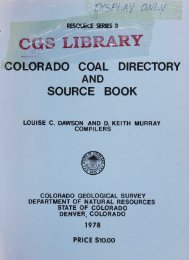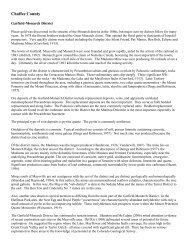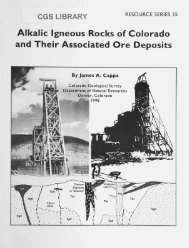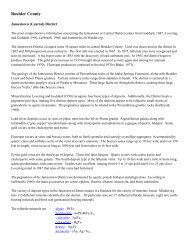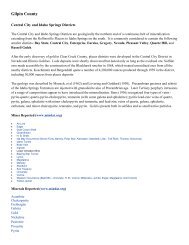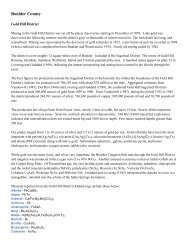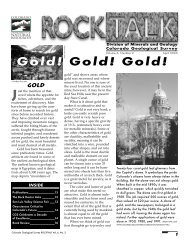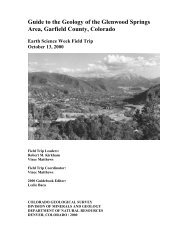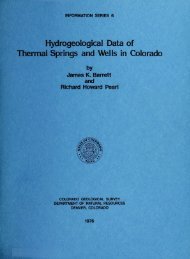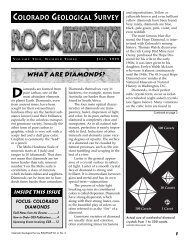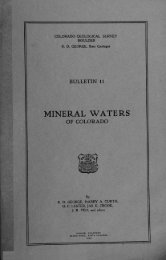Marble - Colorado Geological Survey
Marble - Colorado Geological Survey
Marble - Colorado Geological Survey
Create successful ePaper yourself
Turn your PDF publications into a flip-book with our unique Google optimized e-Paper software.
GEOLOGIC CHARACTERIZATION<br />
INVESTIGATION ACTIVITIES<br />
Literature Review<br />
The earliest written account of the geology of<br />
the Elk Mountain region was produced by the<br />
Hayden <strong>Survey</strong> in the early 1870s. Reports of<br />
their work in the Aspen area, including a<br />
1:125,000 scale geologic map on a topographic<br />
base, are given in the United States <strong>Geological</strong><br />
and Geographical <strong>Survey</strong> Annual Reports of<br />
1874-1876 (Hayden, 1874; Peale, 1874; Hayden,<br />
1876; Holmes, 1876). The map documents<br />
early impressions of the complex structural<br />
features of the area. This work remained the<br />
only published geologic map of the Elk Mountain<br />
region until those of Bryant in 1969-1971<br />
(Bryant, 1969,1970,1971a). Bryant's studies of<br />
the area have appeared in various publications<br />
and are culminated in Geology of the Aspen 15<br />
Minute Quadrangle, Pitkin and Gunnison<br />
Counties, <strong>Colorado</strong>, published in 1979 (Bryant,<br />
1966,1971b, 1972a, 1972b, 1979). Bruce<br />
Bryant's personal input was extremely helpful<br />
throughout this evaluation. Numerous other<br />
workers have also written on the various aspects<br />
of the geology of the Elk Range and their<br />
studies were consulted. An extensive bibliography<br />
accompanies this report.<br />
Aerial Photography<br />
Black and white aerial coverage of the Conundrum-<strong>Colorado</strong><br />
Highland property at a scale of<br />
1:24,000 was produced by Merrick and Company,<br />
under contract to CGS, during June of<br />
1989. The most recent color aerial photography<br />
coverage was produced by the USFS, flight line<br />
No. 1081, photos 201-203, dated September 24,<br />
1982 at 1:24,000 scale. Stereo images from the<br />
1989 photography were digitized by computer<br />
to produce a topographic base map of the area<br />
at a scale of 1 inch equals 400 feet, with a<br />
contour interval of 10 feet. Ground control for<br />
aerial mapping was provided by CGS.<br />
Aerial photography was utilized throughout<br />
the geologic investigation to verify ground observations<br />
and to assist in field location. Ground<br />
textures of the Conundrum Valley as seen on<br />
the aerial photographs have provided insight<br />
into the structural complexity of this area.<br />
<strong>Survey</strong> Control<br />
CGS received all survey notes from USFS in<br />
April of 1989. The Forest Service has not conducted<br />
an official survey of the claim block, but<br />
has recovered existing corners where possible.<br />
The 472.46 acre claim block is comprised of:<br />
The California Placer—MS No. 4928^<br />
153.023 acres, patented April 1891<br />
The Edith M. Placer—MS No. 12334,160.0<br />
acres, patented February 1899<br />
The Vera Placer—MS No. 12335, 20 acres,<br />
patented February 1899<br />
The Vermont Placer—MS No. 12393,<br />
139.434 acres, patented February 1899 (see<br />
Plate 3).<br />
The California Placer was surveyed by Lee<br />
Hayes, U.S. Mineral <strong>Survey</strong>or, on September<br />
13,1887. The Edith M., Vera, and Vermont<br />
Placers were surveyed by George W. Wyce, U.S.<br />
Deputy Mineral <strong>Survey</strong>or, in mid December,<br />
1897. No record of any subsequent boundary<br />
survey for this claim block is in existence. Original<br />
claim corners constructed of rock markers<br />
scribed with claim number and corner designation<br />
have been recovered at various locations<br />
on the property (see Plate 3). CGS has copies of<br />
all original survey notes.<br />
Control for topographic mapping and claim<br />
location was established by CGS in June of<br />
1989. A closed loop traverse of 11,500 feet was<br />
run through panel points and selected claim<br />
corners where available. Horizontal closure<br />
error in the traverse yielded an accuracy ratio<br />
of 1:14,200. This corresponds to a maximum<br />
error of plus or minus 0.814 feet for X and Y<br />
coordinates. Vertical closure error yields an<br />
5



